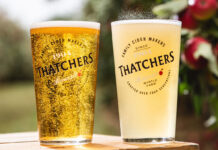Though sometimes ill-defined, the sector is likely to continue to grow in pubs

THE word ‘craft’ has taken on a life of its own in the drinks industry in recent years.
While it’s arguable that most alcoholic drinks involve a certain amount of ‘crafting’ in their production in order to get just right, craft has become a distinct – and increasingly crowded – subsection of drinks all on its own.
For anyone looking to venture into craft products for the first time, whether they are a licensee or a pub customer, the sector can be bemusing – something that isn’t helped by the fact that there is no solid definition of exactly what ‘craft’ actually means.
Opinions vary.
Niall Macalister Hall of Beinn An Tuirc, the producer of Kintyre Gin, said that, in his opinion, a craft product “is handmade in small batches using the minimal amount of automation”.
Ian Weir, brand director at Ian Macleod Distillers, the company behind Edinburgh Gin and Scotch whiskies Smokehead, Tamdhu and Glengoyne, said that – to Ian Macleod – ‘craft’ means “smaller producers with incredible knowledge and expertise, experimenting with flavours and process and above all producing super high-quality with an emphasis on flavour”.
“Craft has been very interesting for the industry because consumers in the know are always seeking their next drink experience, the next product discovery and are increasingly demanding higher quality credentials for their drinks in general,” said Weir.
Others argued that the definition has evolved in recent years.
For me, true craft products are independent or locally produced.
Dale McQueen, co-founder of McQueen Gin, reckoned that the original meaning of craft was a product that “was produced by a non-mechanised, traditionally small, independent” company but that the term has become “a byword for any product that does not have as large a market presence as some of the major brands”.
That, of course, means the term can be extended to products launched by larger companies but that don’t have the name-recognition of those companies’ core brands.
And so McQueen has a different definition.
He said: “For me, true craft products are independent or locally produced goods that did not have the major financial backing of a brand during its launch.
“It would be unfair to say that a brand like Brewdog, who have grown to become a successful multinational company, are no longer considered craft producers.
“However, I also think that misappropriating the term could cheapen the meaning of craft.”
And Justin Wylde, UK brand ambassador at Lowlander Botanical Beers, said that although the definition of craft is “dependent on perception”, he reckoned the “consensus is the brewer is Independent, has provenance and produces unique flavours offering a drinking experience beyond mainstream brands”.
As difficult as it can be to define exactly what craft is, it seemed a little easier to predict where the sector might be headed.
Drinks companies predicted several trends they expected to see throughout 2020 and beyond, including the increasing popularity of low and no-alcohol drinks and even greater experimentation from producers.
Wylde, at Lowlander Botanical Beers, reckoned no and low alcohol products “will continue to drive NPD launches to the market as consumers look to consume less alcohol but improve the experience”.
Gin has been one of the major beneficiaries of the recent ‘craft boom’ and that’s expected to continue through this year.
I think you’ll see more and more community-focused brands popping up.
Michael Vachon, co-founder of distributor Maverick Drinks, said: “Gin still has a way to go.
“It’s getting increasingly local and I think you’ll see more and more community-focused brands popping up in your local watering holes.”
And within gin there could be growth in fruit flavours, according to Eden Mill brand ambassador, Steve Lowrie.
“We see passionfruit continuing its growth,” said Lowrie.
“I think there will be a resurgence in both berries and citrus profiles and more consumers will move into the London Dry Category.
“On a personal note, I’d love to see more bars work with gooseberry, it’s so underused at the moment, yet it has a similar tart flavour compound to grapefruit and goes superbly well with gin.”
Elsewhere in the spirits world rum could be one of the next categories to see an influx of craft products, predicted Rosie Crossman, brand manager for mixer brand Franklin & Sons at parent company Global Brands.
Quoting figures from CGA, Crossman said rum sales are growing at a rate of 5% in the on-trade, with dark rums up 9% and golden rums up 8%, resulting in sales growth of £38 million to the rum category overall.
“This trend will likely see more craft rum brands emerge this year, each bringing something new to the table,” said Crossman.
























